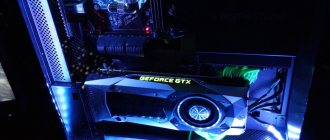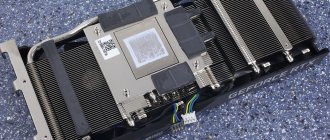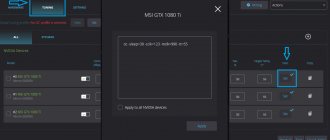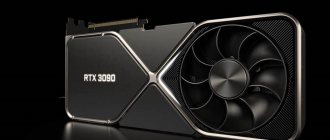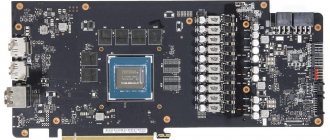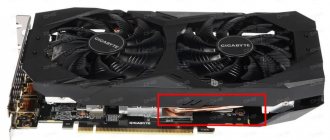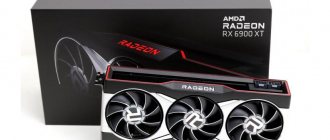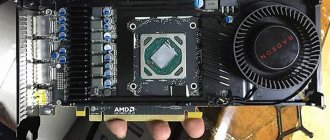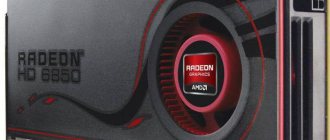Cryptocurrency mining remains one of the most profitable and popular investment methods. Despite the fall in prices on the cryptocurrency market, the number of people wishing to make money on their own farm is not decreasing. The shortage of high-performance video cards is forcing miners to pay attention to simpler GPUs. This time we will look at the lower level device in the AMD line - Radeon RX 550. Mining such popular currencies is quite possible on this inexpensive video card. Let's figure out which cryptocurrencies are worth mining on it and how justified is the use of the RX 550 in mining.
How to choose an inexpensive video card suitable for mining and gaming?
Graphics cards with memory worse than GDDR5 have very poor bandwidth, so they are not worth purchasing for either gaming or mining.
Considering the approximately equal cost of budget graphics adapters, you should not consider purchasing video cards with GDDR3 memory (or worse), even if the computer will be used as a typewriter.
For a price of up to 50 USD, you can now buy new video cards of the GT 710, GTX1030, Radeon RX550-460 level with 2 GB of GDDR5 memory, which will completely cover the needs of an office computer, and will also give you the opportunity to play many games with a performance higher than the integrated video card that bites off memory for system DDR modules.
For that kind of money it is impossible to buy video cards with GDDR5+, GDDR6 and GDDR6+ memory, since they are included in a higher price category. For fifty bucks you can buy passable used video cards, but there is a risk of buying a “repair it yourself” kit with faulty radio components.
In addition, among the old cheap video cards there is not much that is suitable for mining due to low performance and/or high power consumption.
Taking a video card with 1 gigabyte of memory (even GDDR5 type) does not make much sense, since it will not be much stronger than the integrated one, and the price is no different from a two-gigabyte one. In addition, it will obviously be unsuitable for mining on ethash, since the minimum DAG size for any coin using this algorithm is 1 GB.
The choice of video cards with a memory capacity of less than 2 GB is justified only for very weak computers that are practically unsuitable for any profitable mining, so it is not considered in this article.
Conclusion
The problem with RX 550 video cards is that their characteristics allow them to work on the verge of breakeven. Changes in the price of ether or the difficulty of its extraction will lead to the fact that the farm will begin to operate at a loss. Switching it to mining a simpler, but less profitable currency will not work - mining Monero on the RX 550 brings one and a half times less profit than Ethereum. The situation with other currencies is even worse.
Therefore, it is worth making a farm on the RX 550 only if video cards are already available. Otherwise, it is better to invest in faster and more promising hardware.
Why is it better to focus on GDDR5 memory in the budget segment?
Any, even the most expensive DDR4 memory cannot compare with the performance of GDDR5 graphics memory.
In addition, disabling integrated graphics improves the thermal performance of the central processor, which indirectly increases its performance.
This is important both for games and for mining cryptocurrencies using randomx, randomWOW and other CPU-optimized algorithms.
The most affordable models for budget-conscious technology enthusiasts are the Nvidia GT 710/730 models with 2 gigabytes of GDDR5 memory. Nowadays such video cards can be purchased for 30-50 dollars. There are models with a passive cooling system and a small fan. Despite the low consumption level of such video cards, it is worth focusing on models with an active cooling system (fan), as this will protect the video card from overheating on summer days. Unfortunately, the capabilities of the Nvidia GT 710/730 with 2 GB GDDR5 memory in mining cryptocurrencies using PoW algorithms are very limited by the Kepler 2.0 architecture and support for the outdated version of CUDA 3.5. This is due to the fact that the video processors of these video cards have been released for a very long time.
The appearance on the market of supposedly new Nvidia video cards with GK208B chips in 2022 was dictated by the desire to free up warehouses and withdraw some money from consumers. Even on Linux, such cards show records of slowness in calculations. In this regard, it is better to use them to relieve the processor from performing tasks of drawing graphics and playing videos - they do an excellent job with this.
More interesting for multi-threaded computing are the GTX1030, Radeon RX550 and RX460 video cards. They support relatively new versions of CUDA and OpenCL, which allows you to get decent mining results.
BIOS firmware
How to flash an RX 470 video card for mining? To modify the BIOS, the following programs are required:
- ATIWinflash - saves settings and flashes the card.
- SRBPolaris V3-Int - edits BIOS.
- Atikmdag-patcher - adapts the re-flashed GPU to Windows and drivers.
Sequencing
- Open Atiwinflash with administrator rights, if there are several cards, select the one you need and press the right Save to save the original BIOS. It is necessary to make at least two copies, one for editing, the other for returning to the previous settings in case the card does not work correctly after reprogramming.
- Open the BIOS in the SRBPolaris utility to change the timings (time delay scheme for correct execution of operations). We look at the device memory manufacturer. We select values that correspond to the RAM of the video card.
- We edit the timings and save the modified BIOS. Instead of SRBPolaris , you can use PolarisBiosEditor-master with auto-timing selection function . But best of all, get the timings from here: https://forum.bits.media/index.php?/topic/38510-eth-xmrtimingsrx470480570580-optimized-timings-and-configs/
- Click Load image in the Atiwinflash , select the new BIOS modification and give the Program command. After flashing the firmware, the utility will prompt you to restart the PC. Before rebooting, you must run Atikmdag-patcher , otherwise the system may not detect the video card.
It is important to consider:
- Optimized timings of 470 will speed up mining by 25-30% , which is important considering the cost of electricity.
- When submitting flashed video cards for warranty repair, the store has the right to refuse repairs. Be careful if you decide to change your video card settings.
- Claymore's 15 and Phoenix 5.5 miners can modify timings on the fly. In claymore you need to select the values –strap and –rxboost , and in phoenix add the option – mt 1 , or – mt 2 . You will get the same hashrate as with the modified BIOS and will not risk the warranty.
Some features of low-end video cards with GDDR5 memory
Nvidia GT 710/730 video cards with 2 GB GDDR5 can, without any special tricks, stably overclock the core by 50-100 MHz, and the memory even more, since they use modern high-density memory modules.
According to the datasheet, K4G80325FB-HC03 memory chips can operate at a clock frequency of 1250 MHz (effective - 6 Gbps) with a VDD/VDDQ voltage of 1.5/1.5 volts. These are old third-generation chips that still overclock well.
The operating frequency of Samsung memory chips is encoded in the last two digits of the marking:
Thus, the base bandwidth of these cards, equal to 40.1 GB/s, can be expanded by increasing the memory frequency. True, this will not give much effect due to the low memory bus width caused by the use of only two memory modules.
If you do not use voltmods, Nvidia GT 710/730 video cards with 2 GB GDDR5 can be overclocked in the core by 5-10% and in the memory by several hundred MHz (by 50-70%). The core can be overclocked even more (by 30-40%), but the stability of such a video card will not be very high.
Nvidia GTX1030 video card board manufactured by ASUS with 2 GB of memory, equipped with 2 Micron memory chips:
Video cards produced by AMD have 4 memory modules installed on two-gigabyte video cards, which increases the memory bus width to 128 bits, which is twice as much as that of younger nvidia video cards. Therefore, red cards are significantly ahead of Nvidia video cards using the Ethash algorithm.
AMD Sapphire RadeonRX550 video card board with 2 GB of memory, 4 Elpida memory chips:
Although the video cards in question have only 2 GB of memory, they can be used to mine some coins with a small DAG size using the ethash algorithm, for example Dubaicoin on the comining pool.
In this case, you can immediately exclude Nvidia video cards from the race. Although they contain modern memory chips, there are only two of them, which limits the memory bus width to 64 bits.
In addition, the latest nvidia drivers that support CUDA 11.0+ do not support older versions of NVIDIA GPU compute capability. In this regard, Nvidia GT 710/730 video cards with drivers 450.102.04 on ethash produce a ridiculous 0.7-1 mh/s.
Using the verthash algorithm in the verthashminer 0.6.2 program, the Nvidia GT 710 produces only 13.8 kh/s, which is worse than the HD/UHD video adapters built into the Intel processor (more about mining on built-in GPUs in the article “Is it possible to run mining on the integrated video card of an Intel processor ?«).
Mining DBIX cryptocurrency (DAG size 1.33 Gb) on Nvidia GT 710 in Phoenix Miner with drivers:
What you need for mining on the RX 550
In addition to purchasing a video card, you need to have a computer with a HDD of at least 80 gigabytes and 4 GB of RAM or more (it is impossible to install a 64-bit version of Windows on which mining applications run on a smaller size). Even if you buy the most budget models of motherboard, processor, memory, hard drive and power supply, the equipment will be quite expensive. You can improve your return on investment by attaching 4-6 video cards to the farm. This is worth doing, despite the fact that you will have to spend money on a more expensive motherboard model with the corresponding number of PCI-E ports.
There is no hope for effective overclocking, so standard video card fans are sufficient to cool the rig. The problem may be caused by a lack of external power. A heavy load on the motherboard that powers the GPU through the PCI-E ports can lead to premature failure. Therefore, it is worth paying attention to the maximum permissible power of a particular model.
It is better to mine in a pool using Claymore's Miner.
Claymore's Dual Miner.
In addition to the application for mining ether, you will need a software cryptocurrency wallet or an account on a crypto exchange.
The choice of pool depends on your preferences. It is better to choose one of the fairly old and well-known ones: Nanopool, 2Miners, NiceHash or MinerGate. In the corresponding section of the pool you will find compatible mining applications and instructions for setting them up to work with the site.
⇡#Test stand, testing methodology
| Test bench configuration | |
| CPU | Intel Core i7-5960X @ 4 GHz (100 MHz × 40), constant frequency |
| Motherboard | ASUS RAMPAGE V EXTREME |
| RAM | Corsair Vengeance LPX, 2133 MHz, 4 × 4 GB |
| ROM | Intel SSD 520 240 GB + Crucial M550 512 GB |
| power unit | Corsair AX1200i, 1200 W |
| CPU cooling system | Thermalright Archon |
| Frame | CoolerMaster Test Bench V1.0 |
| Monitor | NEC EA244UHD |
| operating system | Windows 10 Pro x64 |
| Software for AMD GPUs | |
| All video cards | Radeon Software Crimson ReLive Edition 17.6.2 (Tesselation: Use application settings) |
| NVIDIA GPU software | |
| All video cards | GeForce Game Ready Driver 382.53 |
| Benchmarks: synthetic | |||
| Test | API | Permission | Full screen anti-aliasing |
| 3DMark Cloud Gate | DirectX 11 (feature level 10_0) | 1280 × 720 | Off |
| 3DMark Sky Diver | DirectX 11 (feature level 11_0) | 1920 × 1080 | |
| 3DMark Fire Strike | DirectX 11 (feature level 11_0) | 1920 × 1080 | |
| Benchmarks: games | |||
| Game (in order of release date) | API | Settings | Full screen anti-aliasing |
| 1920 × 1080 | |||
| Crysis 3 + FRAPS | DirectX 11 | Max. quality. Start of the Swamp mission | Off |
| Metro: Last Light Redux, built-in benchmark | Max. quality | ||
| GTA V, built-in benchmark | Max. quality | ||
| DiRT Rally, built-in benchmark | Max. quality | ||
| Rise of the Tomb Raider, built-in benchmark | DirectX 12 | Max. quality, VXAO off | |
| Tom Clancy's The Division, built-in benchmark | Max. quality, HFTS off | ||
| Ashes of the Singularity, built-in benchmark | Max. quality | ||
| DOOM | Vulkan | Max. quality. Foundry Mission | |
| Total War: WARHAMMER, built-in benchmark | DirectX 12 | Max. quality | |
| Deus Ex: Mankind Divided, built-in benchmark | Max. quality | ||
| Battlefield 1 + OCAT | Max. quality. Start of the Over the Top mission | ||
| Benchmarks: video decoding, computing | |
| Program | Settings |
| DXVA Checker, Decode Benchmark, H.264 | Files 1920 × 1080p (High Profile, L4.1), 3840 × 2160p (High Profile, L5.1). Microsoft H264 Video Decoder |
| DXVA Checker, Decode Benchmark, H.265 | Files 1920 × 1080p (Main Profile, L4.0), 3840 × 2160p (Main Profile, L5.0). Microsoft H265 Video Decoder |
| LuxMark 3.1 x64 | Hotel Lobby Scene (Complex Benchmark) |
| Sony Vegas Pro 13 | Sony benchmark for Vegas Pro 11, duration - 65 s, rendering in XDCAM EX, 1920 × 1080p 24 Hz |
| SiSoftware Sandra 2016 SP1, GPGPU Scientific Analysis | Open CL, FP32/FP64 |
| CompuBench CL Desktop Edition X64, Ocean Surface Simulation | — |
| CompuBench CL Desktop Edition X64, Particle Simulation - 64K | — |
Existing prospects
The RX 550 has no special prospects. They will definitely perform poorly in Bitcoin mining. On a 2GB RX 550, Ether mining is not a good idea. Ethereum’s DAG file weight is rapidly growing, and therefore it will soon be impossible to mine it on such video cards. And therefore, only on the RX 550 4gb is it worth taking up Ethereum mining. For mining, it is better to choose cryptocurrencies like Monero or Zek, this is an ideal option.
It turns out that this option is worth taking a closer look at for those people who have a significantly limited budget. The cards will pay for themselves pretty quickly, and they also don’t consume much energy. But with such a hashrate you won’t go far. The card can be purchased as a small addition, but it cannot be considered as the basis for long-term mining. Most likely, analogues with better performance will soon appear on the market.
Characteristics of AMD RX 5500 XT 8gb.
| Name | Meaning |
| Core | Navi 14 |
| Technical process, nm | 7 |
| Transistors, million | 6400 |
| Core frequency, MHz | 1670–1845 |
| Shader unit operating frequency, MHz | 1670–1845 |
| Shader blocks | 1408 |
| TMU | 88 |
| ROP | 32 |
| Memory operating frequency (DDR), MHz | 1750 (14000) |
| Memory bus | 128-bit GDDR6 |
| Memory | 8192 |
| PSP, GB/s | 224 |
| Shaders Model | 6.4 |
| Fill Rate, Mpix/s | 59040 |
| Fill Rate, Mtex/s | 162400 |
| DirectX | 12 (12_1) |
| Interface | PCI-E 4.0 |
In stock, the video card consumes an average of 80 W, which is a good value, and it is not demanding on power supplies. A rig of six RX 5500 XT can be powered by one good 1000 W power supply, or two 800 W power supplies. The main thing is that there are enough PSU wires with 8-pin connectors.
A cheap 1000 W KCAS Aerocool will not hold up.
You should not connect two video cards to one cable with additional power; overheating of the wiring may occur, both on the wires themselves and on the power lines inside the power supply; one video card loads the line with a current of 30 amperes.
Hashrate
Hashrate is a unit of measurement that determines the computing power of a video card in mining. The higher it is, the better. The hashrate may vary depending on the coin the card is mining. Details are in the table below.
| Coin | Algorithm | Hashrate |
| Expanse (EXP) | DaggerHashimoto EXP | 14.5MH/S |
| Ubiq (UBQ) | Ubqhash | 14.5MH/S |
| Ravencoin (RVN) | KawPow | 3.5MH/S |
⇡#Performance: 3DMark
3DMark is optimistic about the performance of the Radeon RX 550. The new product is ahead of the video card with a larger number of shader ALUs - the Radeon R7 360. At the same time, the integrated GPU in the A10-7870K, despite having almost the same configuration of computing units as the Polaris 12, received fewer half the points scored by the RX 550. But even the modest amount of local memory for the GeForce GTX 750 Ti did not prevent it from taking first place in synthetic tests.
| 3DMark (Graphics Score) | |||||
| Permission | AMD Radeon RX 550 (1190/7000 MHz, 2 GB) | AMD A10-7870K (867/2400 MHz, 2 GB) | AMD Radeon R7 360 (1050/6500 MHz, 2 GB) | NVIDIA GeForce GTX 750 Ti (1020/5400 MHz, 1 GB) | |
| Cloud Gate | 1280 × 720 | 28 120 | 11 757 | 26 263 | 31 312 |
| Sky Diver | 1920 × 1080 | 13 740 | 6 916 | 14 087 | 14 811 |
| Fire Strike | 1920 × 1080 | 4 112 | 2 018 | 4 157 | 4 421 |
| Max. | −50% | +3% | +11% | ||
| Avg. | −53% | −1% | +9% | ||
| Min. | −58% | −7% | +8% | ||
Performance: Gaming (1920 × 1080)
In general, games at maximum quality settings, even at 1080p resolution, are beyond the capabilities of video cards such as the Radeon RX 550. Nevertheless, the results obtained speak rather positively about the device: in a number of tests, the frame rate approaches the target 30 FPS, including in games with excellent graphics - such as Battlefield 1 and Metro: Last Light Redux.
In comparison with its rivals, the Radeon RX 550 took an intermediate position between the integrated AMD A10-7870K graphics core, on the one hand, and the Radeon R7 360 and GeForce GTX 750 Ti class accelerators, on the other. Despite the architectural similarities between the RX 550 and the APU, the performance of the discrete graphics card is 54% higher on average. The Radeon R7 360, in turn, is only 5% ahead of the RX 550. The GeForce GTX 750 Ti could claim an advantage of about 15%, but the categorical lack of RAM (only 1 GB) undermines its position in a number of tests and reduces the average result to 7 percent superiority over Radeon RX 550.
| 1920 × 1080 | |||||
| Full screen anti-aliasing | AMD Radeon RX 550 (1190/7000 MHz, 2 GB) | AMD A10-7870K (867/2400 MHz, 2 GB) | AMD Radeon R7 360 (1050/6500 MHz, 2 GB) | NVIDIA GeForce GTX 750 Ti (1020/5400 MHz, 1 GB) | |
| Ashes of the Singularity | Off | 12 | 6 | 13 | 14 |
| Battlefield 1 | 28 | 13 | 27 | 16 | |
| Crysis 3 | 23 | 11 | 24 | 25 | |
| Deus Ex: Mankind Divided | 11 | 7 | 12 | 8 | |
| DiRT Rally | 23 | 13 | 25 | 29 | |
| DOOM | 21 | 20 | 24 | 26 | |
| GTA V | 25 | 11 | 26 | 30 | |
| Metro: Last Light Redux | 29 | 13 | 30 | 35 | |
| Rise of the Tomb Raider | 20 | 10 | 22 | 16 | |
| Tom Clancy's The Division | TAA: Stabilization | 10 | 6 | 10 | 15 |
| Total War: WARHAMMER* | Off | 21 | 10 | 21 | 22 |
| Max. | −5% | +14% | +50% | ||
| Avg. | −45% | +5% | +7% | ||
| Min. | −56% | −4% | −43% | ||
* In Total War: WARHAMMER, the GeForce GTX 750 Ti runs the DirectX 11 API.

